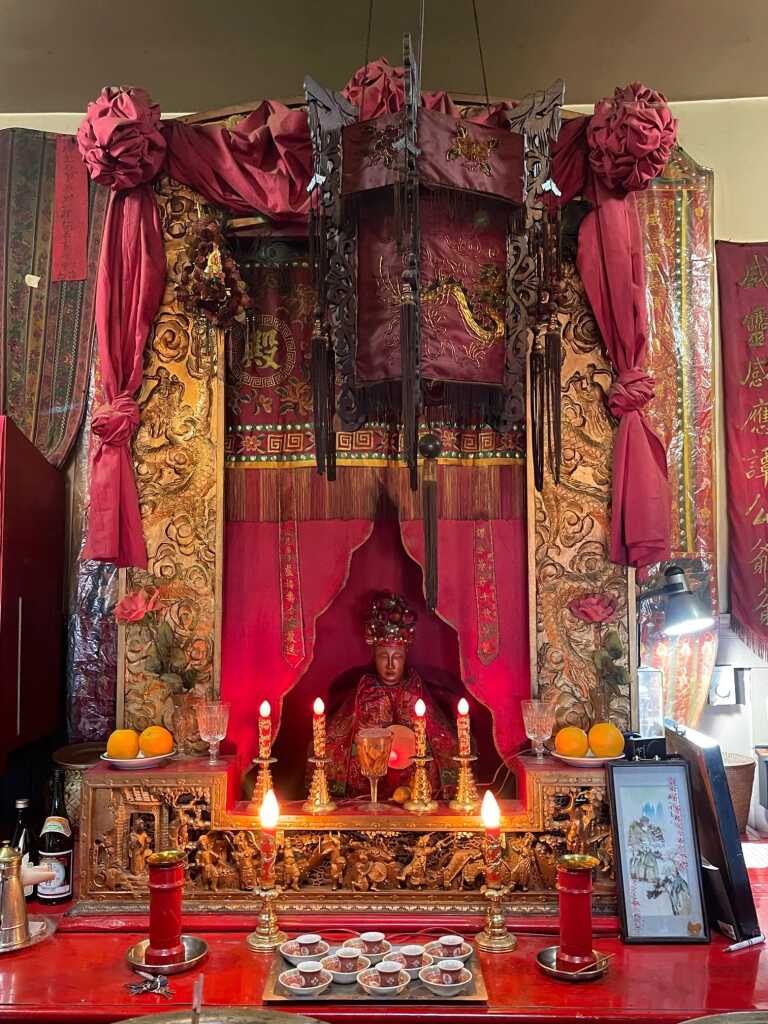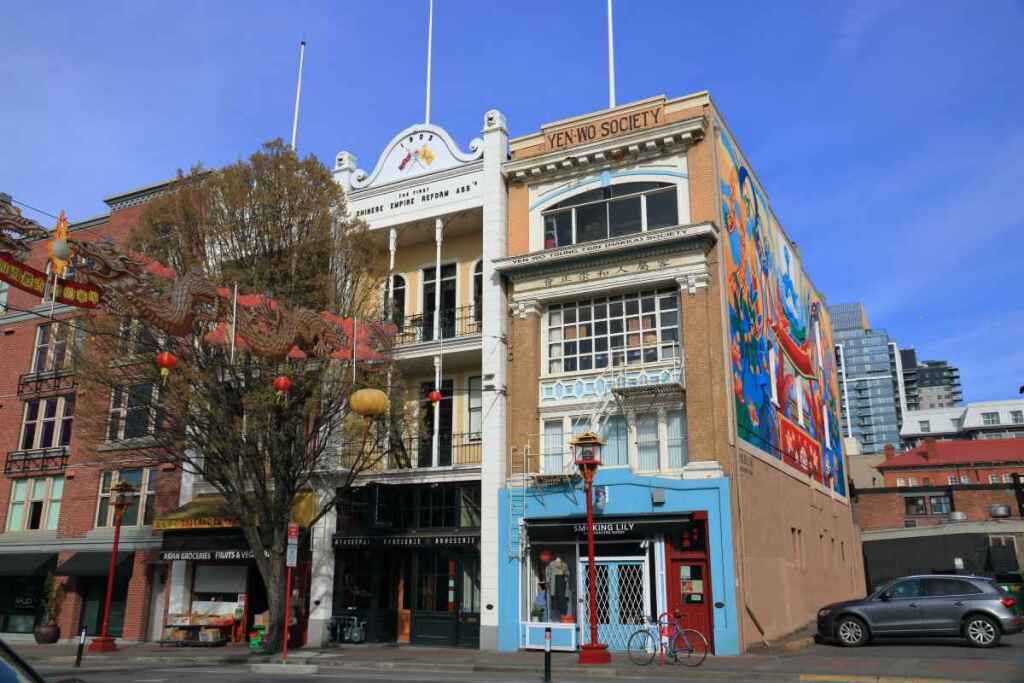Victoria’s historic Tam Kung Temple needs your support! Canada’s oldest Chinese temple and one of the last of its kind still in active use, Tam Kung Temple has been nominated for the National Trust for Canada’s Next Great Save! Your daily vote until April 17 can help this community cornerstone win $50,000 toward urgently needed restoration and accessibility upgrades.
Vote Here Once Per Day!

The statue of Tam Kung at Victoria’s Tam Kung temple. Photo Credit: Unknown. Photo Source: Tam Kung Temple.
About the Tam Kung Temple
The Tam Kung Temple 譚公廟 (taam4 gung1 miu2 | tán gōng miào), located at the top floor of the Yen Wo Society building in Victoria’s historic Chinatown, is the oldest of its kind in Canada. While its current home at 1713 Government Street was built in 1912, the temple is almost half a century older, having been founded in 1876 and with roots in the gold rushes of the 1860s.[1]
The temple honours Tam Kung 譚公 (taam4 gung1 | tán gōng), a traditional deity protecting seafarers and fishers, with the ability to control the weather and heal the sick. A small statute of Tam Kung was first brought to Victoria by Ngai Shee, a Hakka 客家 (haak3 gaa1 | kè jiā) migrant who arrived from Guangdong province in the 1860s. Before leaving to seek his fortune in the goldfields, Ngai Shee left the statue in a wooden box near the Johnson Street Ravine, which ran between Johnson Street at the north end of what was then downtown Victoria, and Cormorant Street (now Pandora Street) marking the beginning of Chinatown.[2]
In 1876, a single-storey temple was built and dedicated near the corner of Fisgard and Government Streets, and by 1877, community members Tsay Ching and Dong Sang had purchased the rented site for the temple. This first iteration stood until 1911, when the Yen Wo Society purchased the site and demolished the temple to make way for its four-storey replacement. The current building was completed in 1912, with the Tam Kung Temple occupying the top floor ever since.[3]
In 1980, the temple was damaged in a fire but was subsequently restored, and by 2022, it was the only Chinese temple still in use in Victoria. It is currently open daily from 10:00am-4:00pm, and was designated a National Historic Site by Parks Canada in March 2025.[4]

The Yen Wo Society building, where the Tam Kung Temple is located on the top floor, Victoria, British Columbia, 2024. Photo Credit: Christian Lieb. Image Source: Tam Kung Temple.
Vote Every Day Until April 17
Tam Kung Temple is one of only ten sites competing across Canada. It is the only Chinese heritage site among the finalists – and it needs your support to win.
🗳️ Click here to vote once per day
📅 Voting runs March 31 to April 17, 2025
🔗 Learn more: tamkungtemple.ca | @tamkungtemple
Sources:
[1] Parks Canada, “Tam Kung Temple National Historic Site” (last modified 5 March 2025), online: <https://www.parks.canada.ca/culture/designation/lieu-site/temple-tam-kung>; “Tam Kung Temple” (last accessed 1 April 2025), online: <https://tamkungtemple.ca/>.
[2] Parks Canada, “Tam Kung Temple National Historic Site” (last modified 5 March 2025), online: <https://www.parks.canada.ca/culture/designation/lieu-site/temple-tam-kung>; “Tam Kung Temple” (last accessed 1 April 2025), online: <https://tamkungtemple.ca/>; “Yen Wo Society: First Chinese Temple and a Hakka Association in Canada” (last accessed 1 April 2025), online: Victoria’s Chinatown: A Gateway to the Past and Present of Chinese Canadians <https://chinatown.library.uvic.ca/index.htmlq%3Dyen_wo_society.html>; “Streets in Transition” (last accessed 1 April 2025), online: Victoria’s Chinatown: A Gateway to the Past and Present of Chinese Canadians <https://chinatown.library.uvic.ca/index.htmlq%3Dstreets.html>; Hong Kong, Antiquities Advisory Board, Tam Tai Sin Temple, Shau Tau, Tung Ping Chau, (Historic Building Appraisal), (last accessed 1 April 2025), online (pdf): <https://www.aab.gov.hk/filemanager/aab/common/historicbuilding/en/800_Appraisal_En.pdf>.
[3] “Yen Wo Society: First Chinese Temple and a Hakka Association in Canada” (last accessed 1 April 2025), online: Victoria’s Chinatown: A Gateway to the Past and Present of Chinese Canadians <https://chinatown.library.uvic.ca/index.htmlq%3Dyen_wo_society.html>; Parks Canada, “Tam Kung Temple National Historic Site” (last modified 5 March 2025), online: <https://www.parks.canada.ca/culture/designation/lieu-site/temple-tam-kung>; “Tam Kung Temple” (last accessed 1 April 2025), online: <https://tamkungtemple.ca/>.
[4] Parks Canada, “Tam Kung Temple National Historic Site” (last modified 5 March 2025), online: <https://www.parks.canada.ca/culture/designation/lieu-site/temple-tam-kung>; “Tam Kung Temple” (last accessed 1 April 2025), online: <https://tamkungtemple.ca/>.
- Parks Canada. “Tam Kung Temple.” https://www.parks.canada.ca/culture/designation/lieu-site/temple-tam-kung. ↩︎
- National Trust for Canada. “Tam Kung Temple.” https://nextgreatsave.nationaltrustcanada.ca/2025/entry/81 ↩︎
- CBC News. “Government of Canada Invests in Repairing Historic Chinese Temple.” CBC News, August 29, 2023. Accessed April 1, 2025. https://www.cbc.ca/news/canada/british-columbia/canada-chinese-temple-repair-1.6829956. ↩︎
- Tam Kung Temple. “Support Tam Kung Temple in the Next Great Save Competition!” https://tamkungtemple.ca/nextgreatsave2025. ↩︎






